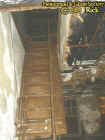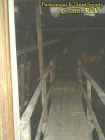| |
The
Erie Train Station is a very gothic looking building embedded on the
hillside. This reminded me of a small version of Central Terminal Station
here in Buffalo. The one thing that stands out most is the clock in the
front of the building. The train station is very vandalized as their are
some holes in the windows. The bars on the windows giving the place a more
foreboding feel. We wanted to investigate this since it is a fact most
train stations are haunted by ghost who still think they are boarding
there next train. Alot of residual energy would be the obvious at place
such as this. I have posted below a little history on the Train Station
and the Erie Railroad the articles are very informative and contain a
little history. The one thing that is enjoyable when walking around this
place is the arched ceilings, tiled floors, and the old oak benches that
still are here. The place is very large and in my opinion I do think a few
ghost reside here or some sort of residual energy you can just feel it
here.
Copyright
By
Rick-AngelOfThyNight










More
prologue photos from inside this grand place and investigation coming
soon!!!
Erie
Lackawanna Railroad Passenger Station
The
passenger station of the Erie Railroad, built in 1931, was central to
Jamestown’s bustling daily life and served as the gateway to the city,
and to the outside world. Both historically and architecturally
significant, the station stands as a reminder of the cultural and economic
impact of the railroad on the development of Jamestown. Currently vacant,
the station suffers from general neglect and, given its condition and
location, if it continues to deteriorate, it is in danger of being
demolished.
Jamestown was a growing and thriving
community in the heyday of the railroad. The arrival of the Erie Railroad
in 1860 was the catalyst for development in terms of both tourism and
industry. The area’s agricultural products and manufactured goods flowed
along this economic lifeline and travelers enjoyed years of reliable
passenger service.
Throughout the late nineteenth and early twentieth centuries, rail
passenger facilities in Jamestown saw a steady improvement. In 1865 the
first railroad station was erected, followed in 1897 by a larger, more
impressive brick station. Finally, in 1931, the last and grandest station
to be erected.
The architect for the station was Erie Railroad architect Graham King. The
design shares characteristics displayed by more monumental contemporary
Art Deco buildings in Western New York as Feldheimer and Wagner’s New
York Central Terminal (1929) in Buffalo and John Wade’s Buffalo City
Hall (1929). The station is a fine local example of the Art Deco, a style
of architecture that was popular nationwide in the 1920s and 1930s,
especially for commercial and institutional buildings. It brought to
Jamestown an element of modernity and elegance that was suggestive of the
progressive values of the bustling city, the hopes of the Erie Railroad
for a bright future, and the glamour of travel that awaited passengers
upon such celebrated trains as the Erie Limited.
In 1962 the Erie merged with the Delaware, Lackawanna & Western
Railroad to create the Erie-Lackawanna Railroad. The railroad eventually
succumbed to competition from auto, bus, truck and airplane traffic and in
1970, it suspended passenger service to Jamestown.
The building suffers from water
infiltration, vandalism and general neglect of both its interior and
exterior. The train station is situated directly across the street from a
new, privately funded $21 million dual pad ice arena complex, which had
its grand opening ceremonies in October 2002. In addition, there is a $3
million hotel complex underway in the same area. Due to the train
station’s condition and proximity to this new development, there have
been serious discussions of the station’s future. One idea put forward
is its demolition for a parking lot.
The Downtown Jamestown Development Corporation, Fenton History Center,
City of Jamestown, Chautauqua County and Chautauqua County Visitors Bureau
have all come together to try to save and restore the Station. The threat
of demolition can be eliminated if funding can be secured to, at a
minimum, land bank the building for future development. This would protect
the building from further deterioration while the local community explores
options for additional funding to redevelop the station.
The station is ideally suited to serve as a welcome center for Jamestown
and offers the potential for many related uses. The Fenton History Center
has expressed interest in operating a small retail shop in the entry area
and housing exhibits in the passenger terminal. A seasonal farmer’s
market could operate from the loading dock area and the Western New York
Railway Historical Society has proposed development of tourist excursions
along existing rail lines. And, the station could become a bus transfer
point for the Chautauqua Area Regional Transit System (CARTS), which
currently lacks an indoor hub.
When the station cornerstone was laid on November 16, 1931, the building
was described as “having been designed to express the mutual confidence
of the Erie Railroad and the City of Jamestown for the future of both.”
History has an opportunity to repeat itself as a new generation of
Jamestown leaders express their vision for the community’s future. With
proper planning and adequate funding, the Erie-Lackawanna Railroad
Passenger Station can become an anchor facility and public asset,
complementing the exciting redevelopment underway in downtown Jamestown.
The Erie Railroad
History
The primary railroad of Jamestown has always been
the east-west main line between New York and Chicago. Jamestown was linked
the rest of the world on August 25, 1860 when the first train arrived from
New York on the Atlantic & Great Western Railroad. The A&GW was
reorganized in March 1880 as the New York, Pennsylvania & Ohio (NYPANO),
which was leased and later purchased by the Erie Railroad. In 1962, the
Erie merged with the Delaware, Lackawanna & Western (DL&W) to form
the Erie-Lackawanna Railroad which itself was merged into Conrail in 1976.
News articles from the Jamestown newspapers in
1860 describe the approach of the rails, the debate over the location of
the depot, and the ceremony celebrating the completion of the line to
Jamestown. A 1902 article from the Jamestown newspaper describes the early
years of the A&GW in Jamestown from the point of view of early company
workers.
|
|














